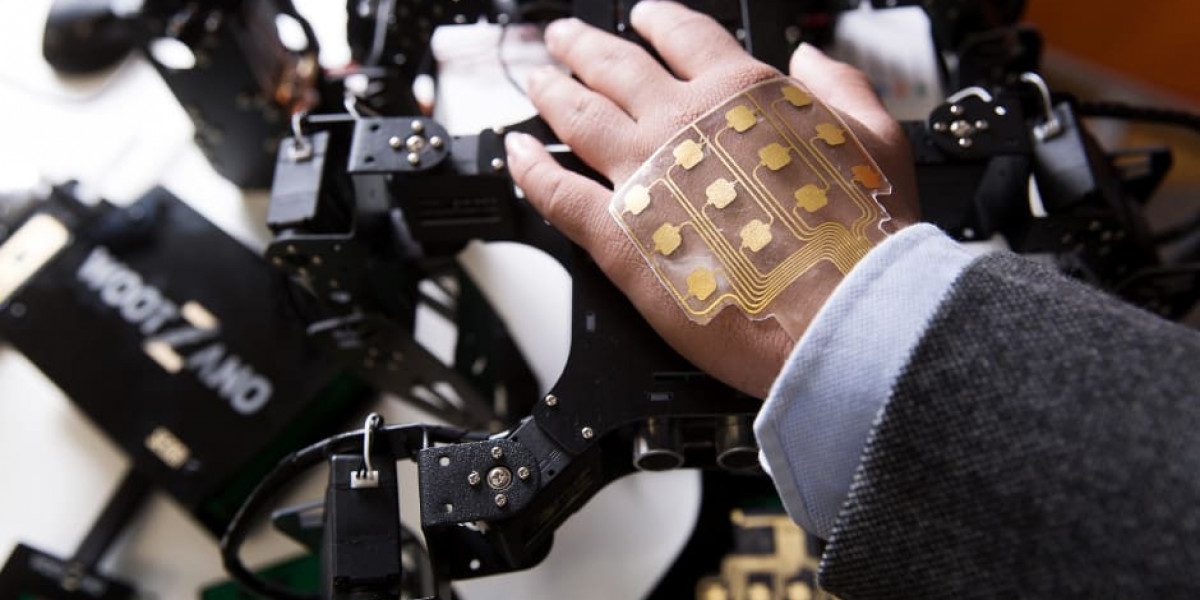The electronic skin market is experiencing rapid development, with e-skin technology showing significant promise in industries such as healthcare, robotics, and wearable electronics. However, despite its potential, there are several barriers that continue to prevent its widespread adoption and growth. These barriers include high production costs, material limitations, regulatory challenges, consumer resistance, and sustainability concerns. This article examines these key barriers and discusses how they are affecting the future of the electronic skin market.
1. High Production Costs
One of the primary barriers facing the electronic skin market is the high cost of production. Manufacturing e-skin devices involves the use of advanced materials, such as conductive polymers, graphene, and stretchable sensors, which are both expensive and complex to produce. Additionally, the production process itself is labor-intensive and requires specialized equipment. This results in a high cost per unit for e-skin devices, which can limit their affordability for mass-market adoption.
For example, healthcare applications, such as wearable health monitors or prosthetic limbs, require e-skin devices to meet strict performance and safety standards. These devices must be durable, comfortable, and reliable, which adds to the production cost. Until manufacturers find more cost-effective ways to scale production or develop cheaper materials, the high cost of e-skin devices will remain a significant barrier to their widespread use in various industries.
2. Material Limitations
Material limitations represent another significant barrier in the electronic skin market. E-skin technology relies heavily on the development of advanced materials that can mimic the properties of human skin while also offering durability, flexibility, and conductivity. While there have been substantial advancements in materials like conductive polymers and flexible electronics, there is still no single material that meets all the required specifications for e-skin devices.
For instance, e-skin must be flexible enough to conform to the contours of the human body while maintaining its functionality under different conditions, such as temperature fluctuations, moisture, and wear and tear. Additionally, materials used in e-skin devices must be biocompatible, particularly for medical applications. The current materials on the market often fall short in one or more of these areas, preventing e-skin technology from reaching its full potential.
Furthermore, the lack of durable, long-lasting materials for e-skin devices presents another hurdle. Many of the materials used in e-skin applications degrade over time, reducing their performance and lifespan. Until more advanced materials are developed that can withstand prolonged use without losing functionality, this barrier will continue to slow the growth of the electronic skin market.
3. Regulatory Challenges
The electronic skin market faces considerable regulatory challenges, especially for e-skin devices that are used in healthcare and medical applications. E-skin devices, such as wearable sensors for health monitoring or prosthetic limbs, must undergo rigorous testing and approval by regulatory bodies such as the U.S. Food and Drug Administration (FDA) and the European Medicines Agency (EMA). This approval process is designed to ensure the safety and efficacy of e-skin devices, but it can also significantly delay their time-to-market.
Regulatory requirements for e-skin devices vary by region and application, making it difficult for manufacturers to navigate the approval process. Clinical trials, safety studies, and documentation requirements can be expensive and time-consuming, particularly for small companies or startups. In addition, the lack of standardized testing protocols for e-skin technology can create uncertainty and delay the approval process further.
Until clearer regulatory frameworks are established and manufacturers find more efficient ways to meet regulatory requirements, the growth of the electronic skin market will be constrained.
4. Consumer Resistance and Awareness
Consumer resistance is another barrier to the widespread adoption of e-skin technology. Many consumers are unfamiliar with e-skin devices and may not fully understand the benefits or applications of the technology. As a result, there is a lack of demand for e-skin products in the consumer market.
For instance, wearable e-skin devices, such as health-monitoring patches or smart clothing, must meet high standards for comfort, usability, and practicality. If the devices are uncomfortable to wear, difficult to use, or cause skin irritation, consumers will be hesitant to adopt them. Similarly, the high cost of these devices may deter potential buyers, particularly in a consumer market where many people are still uncertain about the value of e-skin technology.
Addressing consumer concerns, improving product design, and educating the public about the potential applications of e-skin devices will be essential for overcoming this barrier. Until consumer awareness and acceptance of e-skin technology increase, the market will struggle to gain traction.
5. Data Privacy and Security Concerns
As e-skin devices become more integrated into wearable health technology, data privacy and security concerns are becoming increasingly important. Many e-skin devices collect sensitive personal data, such as heart rate, skin temperature, or motion patterns, which is often stored and transmitted through cloud-based systems or smartphone applications. This raises significant concerns about the security of personal health information.
Data breaches, unauthorized access, or the misuse of sensitive health data are major risks associated with the use of e-skin devices. Consumers may be reluctant to use e-skin products if they fear their personal information is vulnerable to cyberattacks or third-party exploitation. In response, manufacturers must implement robust data security measures and ensure that their devices comply with privacy regulations, such as the General Data Protection Regulation (GDPR) in the European Union.
Failure to address these data security concerns could undermine consumer trust in e-skin technology, limiting its adoption and slowing market growth.
6. Environmental Impact and Sustainability
Environmental sustainability is an increasingly important consideration in the development of e-skin devices. Like other electronic devices, e-skin products contribute to electronic waste (e-waste), which is a growing environmental concern. The materials used in e-skin devices, such as flexible polymers and conductive metals, are often not biodegradable, raising questions about the long-term environmental impact of these products.
Consumers and regulators are becoming more focused on sustainability, and there is increasing pressure for manufacturers to reduce the environmental footprint of their products. Companies that fail to develop eco-friendly materials or recycling programs may face resistance from environmentally conscious consumers and regulatory bodies.
Addressing the environmental impact of e-skin technology will be critical for ensuring the long-term viability of the market. Manufacturers will need to prioritize sustainability in their product designs and production processes to meet the growing demand for eco-friendly electronics.
7. Mass Market Integration
The final barrier to widespread adoption is the challenge of integrating e-skin devices into the mass market. While e-skin technology has seen significant success in niche applications, such as healthcare and robotics, it has yet to achieve widespread penetration in the consumer electronics market. The high cost of production, combined with regulatory and material limitations, makes it difficult for companies to scale production and make e-skin devices affordable for a broader audience.
For e-skin technology to reach its full potential, manufacturers must find ways to reduce production costs, improve materials, and develop products that are accessible to a wide range of consumers. Only then will the electronic skin market be able to achieve significant growth.
8. Conclusion
The electronic skin market faces several barriers that must be overcome for the technology to reach its full potential. High production costs, material limitations, regulatory challenges, consumer resistance, data security concerns, environmental sustainability, and mass market integration are all significant obstacles to the widespread adoption of e-skin devices. By addressing these barriers, manufacturers and innovators can unlock the full potential of e-skin technology, leading to significant advancements in healthcare, robotics, wearable electronics, and beyond.
Learn more: https://www.pristinemarketinsights.com/electronic-skin-market-report









